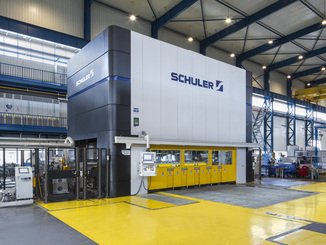
The shift to electromobility and digitalization offers many risks for both Schuler and its customers, but just as many opportunities. This was stated by CEO Domenico Iacovelli at the company’s press conference at the Blechexpo trade fair in Stuttgart (Germany). Using the example of a C-frame press, Schuler will be demonstrating how the productivity and availability of lines can be increased with digital solutions.
Schuler itself is also in the midst of a transformation that is already showing its first positive results. “As of today, we are seeing a significant increase in new orders compared to last year,” Iacovelli said.
Although sales were weak, as expected, the Schuler Group will probably still succeed in generating positive profits: “Our cost discipline, numerous innovations and corporate strategy are paying off.”
Under the name “Core”, Schuler has launched a program designed to pool strengths, further accelerate innovations and consolidate the organization. Many of these goals have already been achieved: for example, in the form of end-to-end standardization of products, the development of solutions for networking forming technology – which Schuler has brought together in its “Digital Suite” – and the manufacture of lines in the home regions of the respective customers (“local for local” philosophy) in order to reduce delivery times and cut costs.
Added to this are the opportunities in the field of electromobility, in which Schuler is already registering a high level of incoming orders. “We supply numerous renowned e-car and battery manufacturers,” Iacovelli clarified. Stamp-packed electrical sheets for high-performance motors can also be produced highly efficiently on the company’s presses. Schuler also recently signed a cooperation agreement with its sister company Andritz Soutec and Thyssenkrupp Automation Engineering for plant technology for the mass production of fuel cells.
Schuler is also constantly expanding and adding to its Digital Suite solutions. The latest example is the VDP Analyzer, the further development of the camera-based die monitoring system “Visual Die Protection” (VDP). The system detects foreign objects or other sources of danger in real time and stops the system before any damage occurs. The “VDP Analyzer” shows users exactly when deviations from the normal state have occurred on the video images. This now also allows you to get to the bottom of the error causes.



